maintenance LINCOLN MKZ HYBRID 2013 Owners Manual
[x] Cancel search | Manufacturer: LINCOLN, Model Year: 2013, Model line: MKZ HYBRID, Model: LINCOLN MKZ HYBRID 2013Pages: 475, PDF Size: 3.89 MB
Page 3 of 475
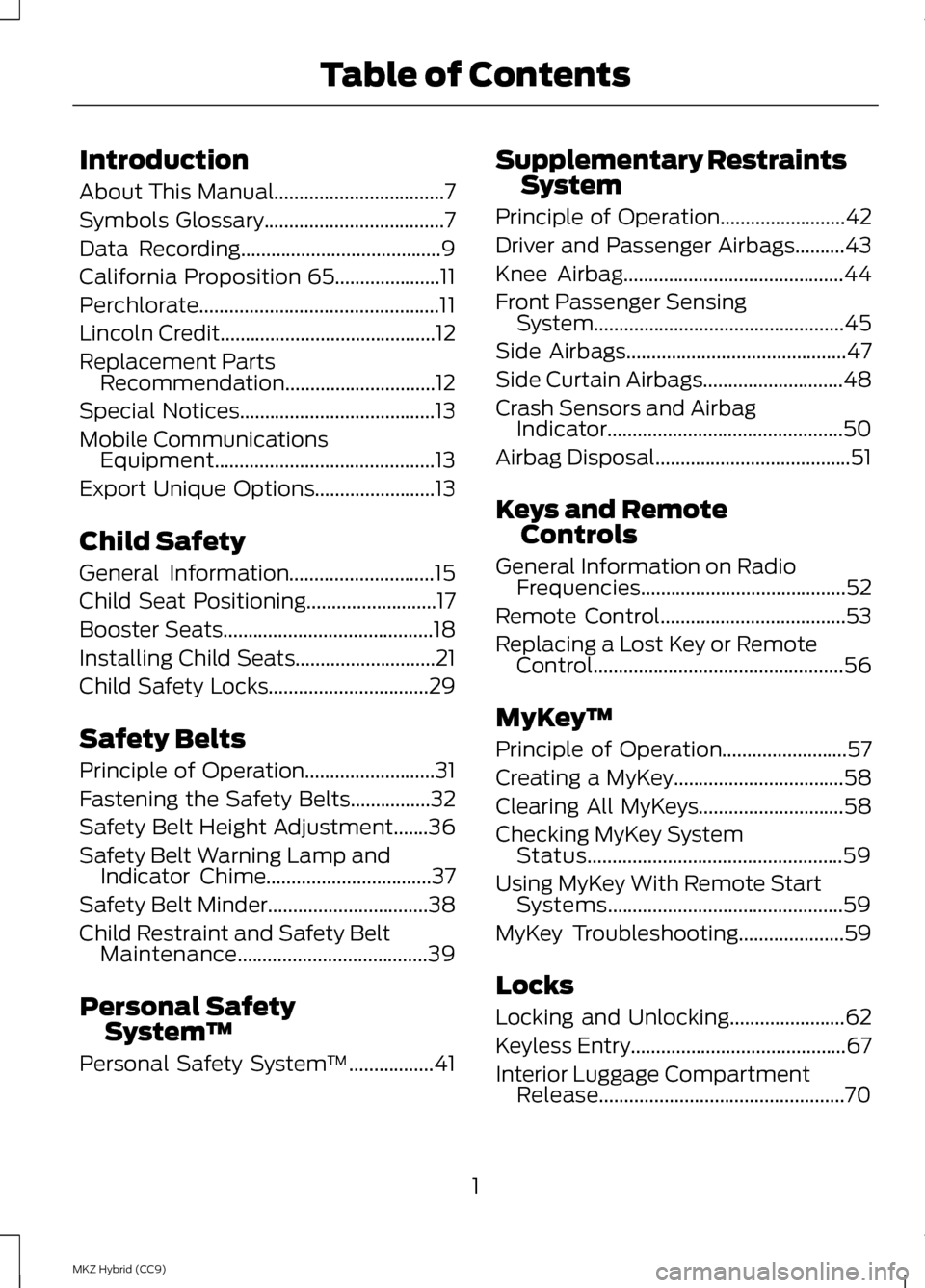
Introduction
About This Manual..................................7
Symbols Glossary
....................................7
Data Recording........................................9
California Proposition 65
.....................11
Perchlorate................................................11
Lincoln Credit
...........................................12
Replacement Parts Recommendation..............................12
Special Notices
.......................................13
Mobile Communications Equipment............................................13
Export Unique Options........................13
Child Safety
General Information.............................15
Child Seat Positioning
..........................17
Booster Seats
..........................................18
Installing Child Seats
............................21
Child Safety Locks................................29
Safety Belts
Principle of Operation..........................31
Fastening the Safety Belts................32
Safety Belt Height Adjustment.......36
Safety Belt Warning Lamp and Indicator Chime.................................37
Safety Belt Minder
................................38
Child Restraint and Safety Belt Maintenance......................................39
Personal Safety System ™
Personal Safety System ™
.................41Supplementary Restraints
System
Principle of Operation
.........................42
Driver and Passenger Airbags..........43
Knee Airbag
............................................44
Front Passenger Sensing System..................................................45
Side Airbags............................................47
Side Curtain Airbags............................48
Crash Sensors and Airbag Indicator...............................................50
Airbag Disposal.......................................51
Keys and Remote Controls
General Information on Radio Frequencies.........................................52
Remote Control
.....................................53
Replacing a Lost Key or Remote Control..................................................56
MyKey ™
Principle of Operation.........................57
Creating a MyKey
..................................58
Clearing All MyKeys.............................58
Checking MyKey System Status...................................................59
Using MyKey With Remote Start Systems...............................................59
MyKey Troubleshooting
.....................59
Locks
Locking and Unlocking.......................62
Keyless Entry...........................................67
Interior Luggage Compartment Release
.................................................70
1
MKZ Hybrid (CC9) Table of Contents
Page 6 of 475
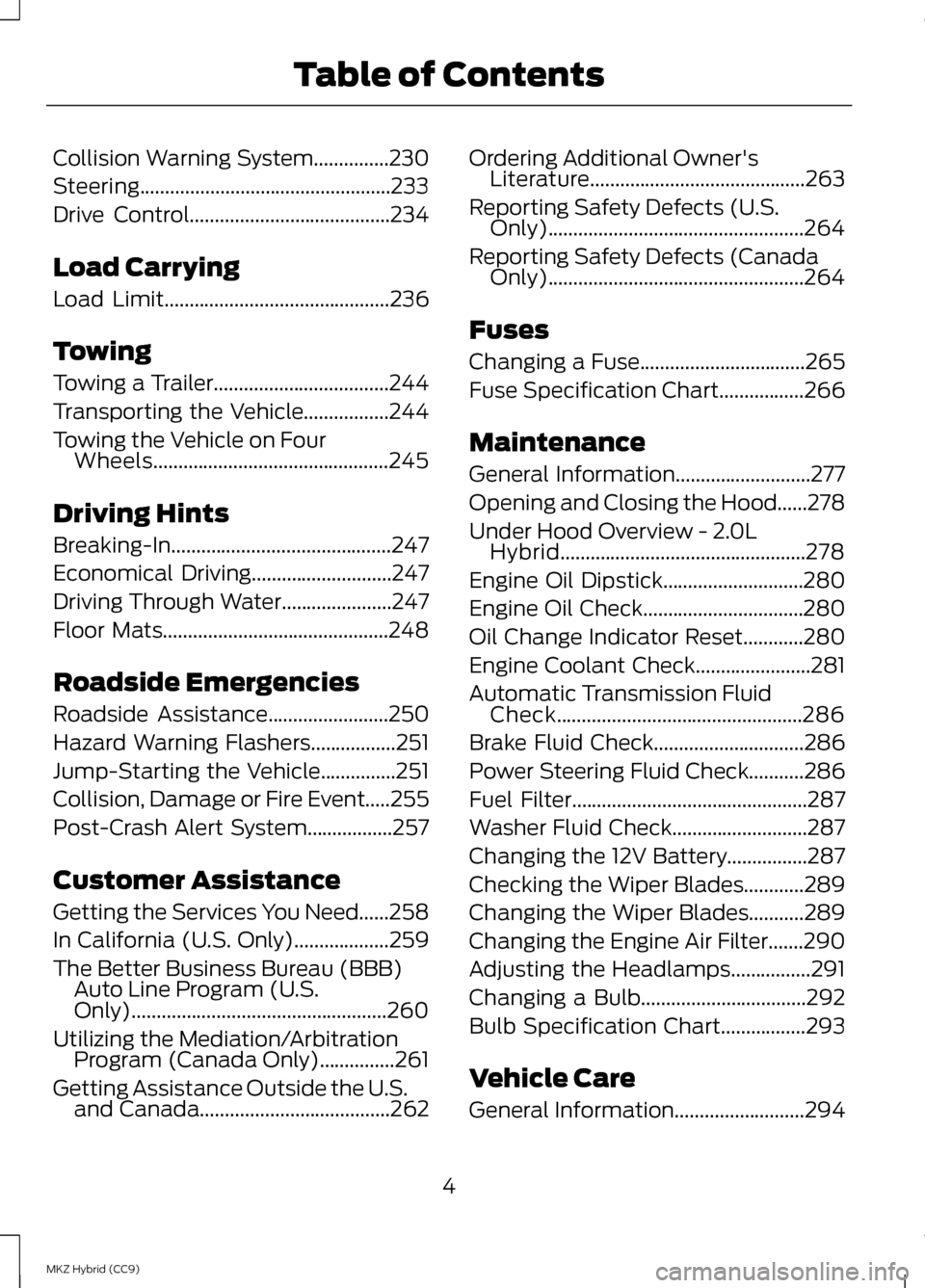
Collision Warning System...............230
Steering..................................................233
Drive Control........................................234
Load Carrying
Load Limit.............................................236
Towing
Towing a Trailer...................................244
Transporting the Vehicle.................244
Towing the Vehicle on Four Wheels...............................................245
Driving Hints
Breaking-In............................................247
Economical Driving............................247
Driving Through Water
......................247
Floor Mats
.............................................248
Roadside Emergencies
Roadside Assistance........................250
Hazard Warning Flashers
.................251
Jump-Starting the Vehicle...............251
Collision, Damage or Fire Event.....255
Post-Crash Alert System.................257
Customer Assistance
Getting the Services You Need
......258
In California (U.S. Only)...................259
The Better Business Bureau (BBB) Auto Line Program (U.S.
Only)...................................................260
Utilizing the Mediation/Arbitration Program (Canada Only)...............261
Getting Assistance Outside the U.S. and Canada
......................................262 Ordering Additional Owner's
Literature...........................................263
Reporting Safety Defects (U.S. Only)...................................................264
Reporting Safety Defects (Canada Only)...................................................264
Fuses
Changing a Fuse.................................265
Fuse Specification Chart.................266
Maintenance
General Information...........................277
Opening and Closing the Hood......278
Under Hood Overview - 2.0L Hybrid.................................................278
Engine Oil Dipstick............................280
Engine Oil Check................................280
Oil Change Indicator Reset............280
Engine Coolant Check
.......................281
Automatic Transmission Fluid Check.................................................286
Brake Fluid Check
..............................286
Power Steering Fluid Check...........286
Fuel Filter
...............................................287
Washer Fluid Check...........................287
Changing the 12V Battery................287
Checking the Wiper Blades............289
Changing the Wiper Blades...........289
Changing the Engine Air Filter.......290
Adjusting the Headlamps................291
Changing a Bulb.................................292
Bulb Specification Chart.................293
Vehicle Care
General Information
..........................294
4
MKZ Hybrid (CC9) Table of Contents
Page 7 of 475
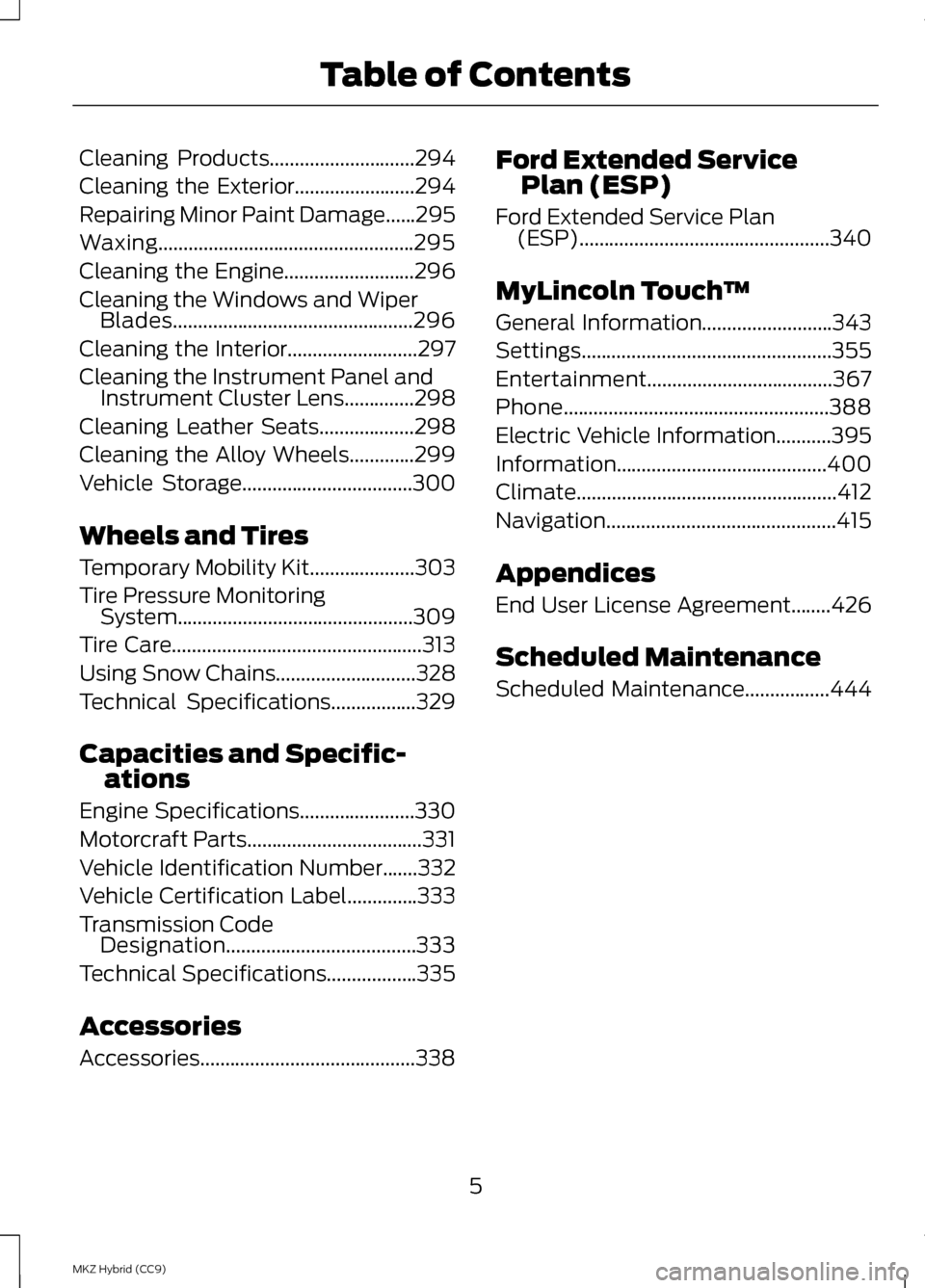
Cleaning Products.............................294
Cleaning the Exterior........................294
Repairing Minor Paint Damage
......295
Waxing...................................................295
Cleaning the Engine..........................296
Cleaning the Windows and Wiper Blades................................................296
Cleaning the Interior..........................297
Cleaning the Instrument Panel and Instrument Cluster Lens..............298
Cleaning Leather Seats...................298
Cleaning the Alloy Wheels.............299
Vehicle Storage
..................................300
Wheels and Tires
Temporary Mobility Kit
.....................303
Tire Pressure Monitoring System...............................................309
Tire Care..................................................313
Using Snow Chains............................328
Technical Specifications
.................329
Capacities and Specific- ations
Engine Specifications.......................330
Motorcraft Parts
...................................331
Vehicle Identification Number
.......332
Vehicle Certification Label
..............333
Transmission Code Designation......................................333
Technical Specifications..................335
Accessories
Accessories...........................................338 Ford Extended Service
Plan (ESP)
Ford Extended Service Plan (ESP)
..................................................340
MyLincoln Touch ™
General Information
..........................343
Settings..................................................355
Entertainment.....................................367
Phone.....................................................388
Electric Vehicle Information
...........395
Information..........................................400
Climate....................................................412
Navigation..............................................415
Appendices
End User License Agreement........426
Scheduled Maintenance
Scheduled Maintenance
.................444
5
MKZ Hybrid (CC9) Table of Contents
Page 14 of 475
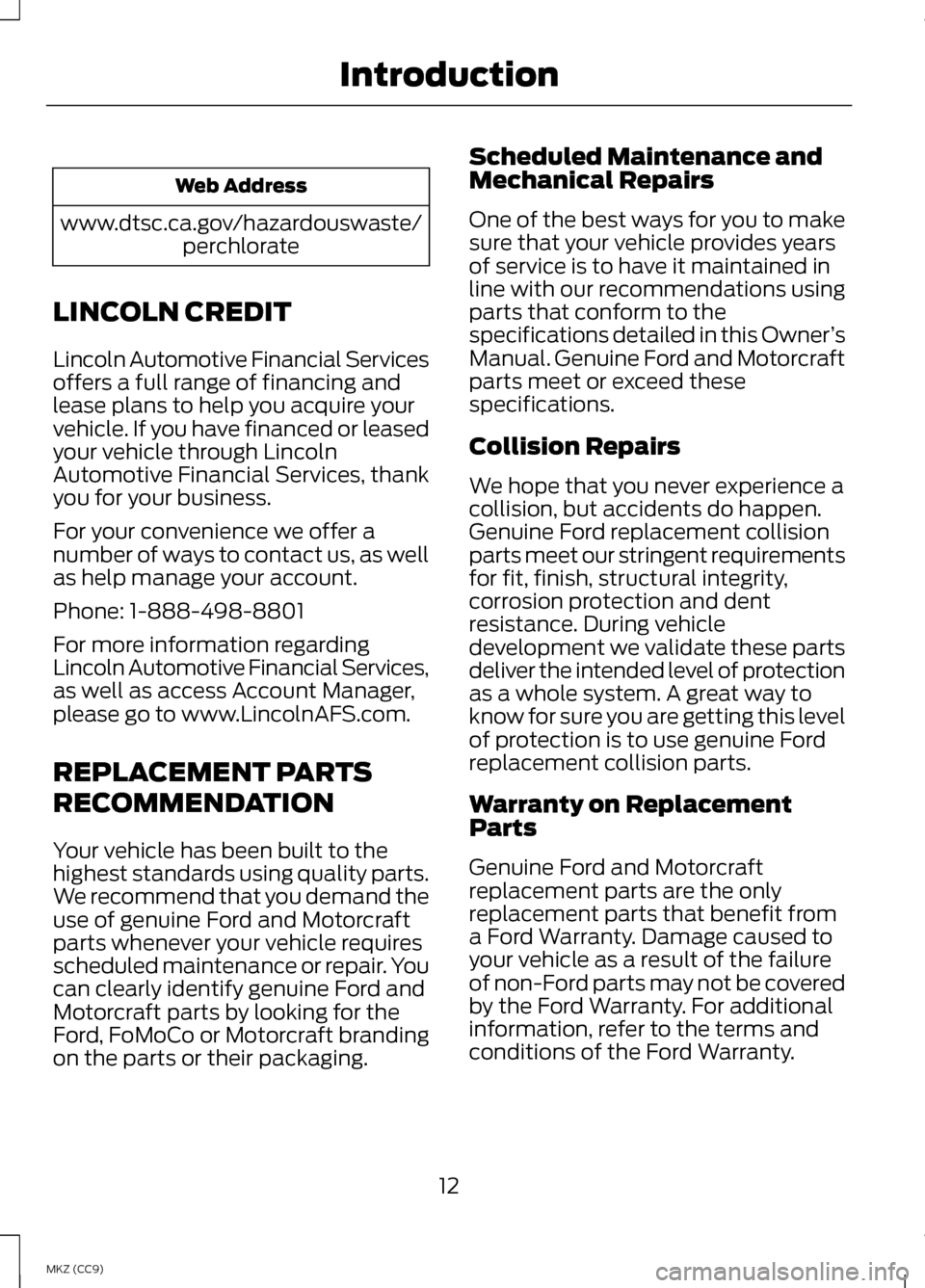
Web Address
www.dtsc.ca.gov/hazardouswaste/ perchlorate
LINCOLN CREDIT
Lincoln Automotive Financial Services
offers a full range of financing and
lease plans to help you acquire your
vehicle. If you have financed or leased
your vehicle through Lincoln
Automotive Financial Services, thank
you for your business.
For your convenience we offer a
number of ways to contact us, as well
as help manage your account.
Phone: 1-888-498-8801
For more information regarding
Lincoln Automotive Financial Services,
as well as access Account Manager,
please go to www.LincolnAFS.com.
REPLACEMENT PARTS
RECOMMENDATION
Your vehicle has been built to the
highest standards using quality parts.
We recommend that you demand the
use of genuine Ford and Motorcraft
parts whenever your vehicle requires
scheduled maintenance or repair. You
can clearly identify genuine Ford and
Motorcraft parts by looking for the
Ford, FoMoCo or Motorcraft branding
on the parts or their packaging. Scheduled Maintenance and
Mechanical Repairs
One of the best ways for you to make
sure that your vehicle provides years
of service is to have it maintained in
line with our recommendations using
parts that conform to the
specifications detailed in this Owner
’s
Manual. Genuine Ford and Motorcraft
parts meet or exceed these
specifications.
Collision Repairs
We hope that you never experience a
collision, but accidents do happen.
Genuine Ford replacement collision
parts meet our stringent requirements
for fit, finish, structural integrity,
corrosion protection and dent
resistance. During vehicle
development we validate these parts
deliver the intended level of protection
as a whole system. A great way to
know for sure you are getting this level
of protection is to use genuine Ford
replacement collision parts.
Warranty on Replacement
Parts
Genuine Ford and Motorcraft
replacement parts are the only
replacement parts that benefit from
a Ford Warranty. Damage caused to
your vehicle as a result of the failure
of non-Ford parts may not be covered
by the Ford Warranty. For additional
information, refer to the terms and
conditions of the Ford Warranty.
12
MKZ (CC9) Introduction
Page 41 of 475
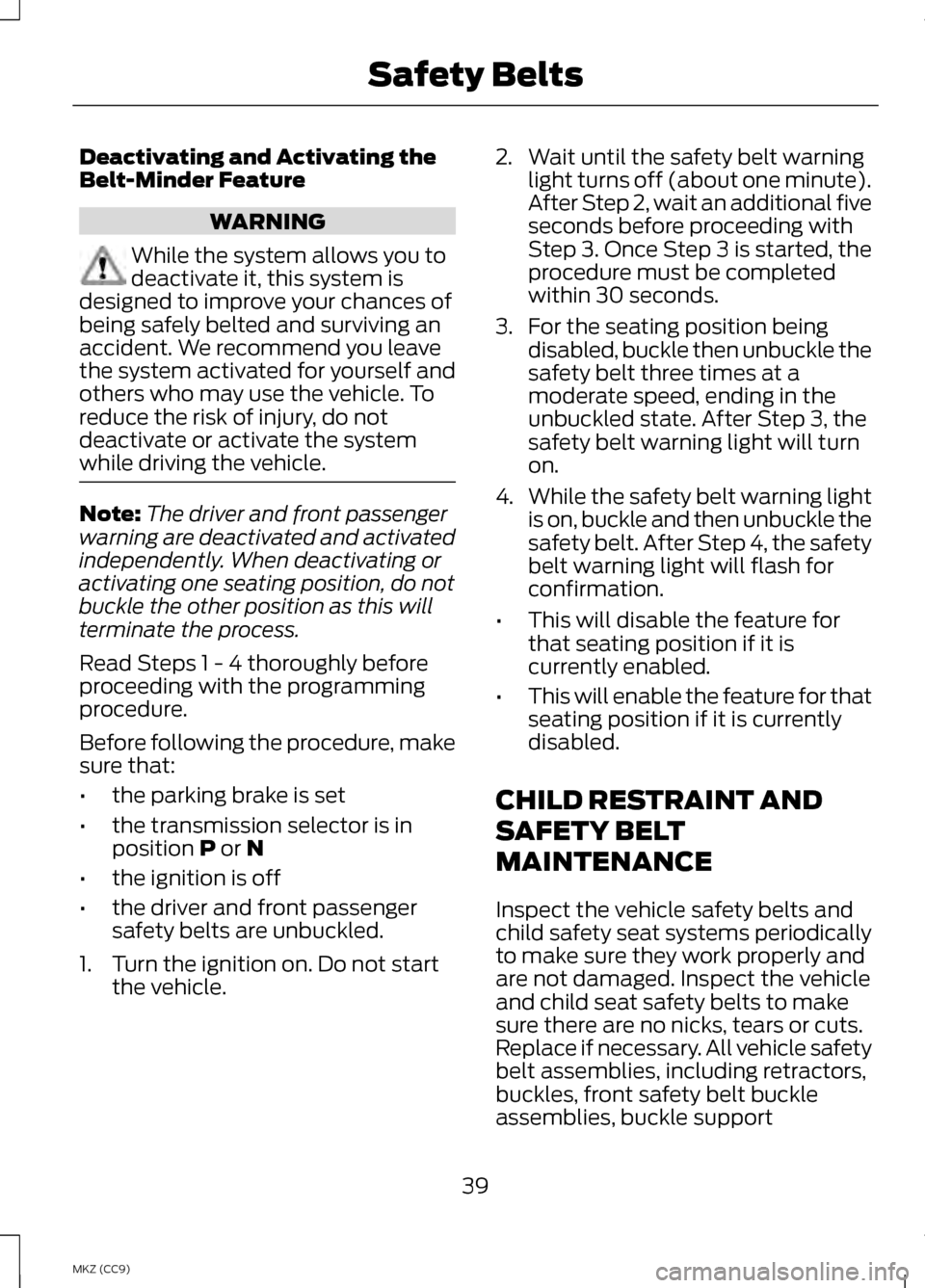
Deactivating and Activating the
Belt-Minder Feature
WARNING
While the system allows you to
deactivate it, this system is
designed to improve your chances of
being safely belted and surviving an
accident. We recommend you leave
the system activated for yourself and
others who may use the vehicle. To
reduce the risk of injury, do not
deactivate or activate the system
while driving the vehicle. Note:
The driver and front passenger
warning are deactivated and activated
independently. When deactivating or
activating one seating position, do not
buckle the other position as this will
terminate the process.
Read Steps 1 - 4 thoroughly before
proceeding with the programming
procedure.
Before following the procedure, make
sure that:
• the parking brake is set
• the transmission selector is in
position P or N
• the ignition is off
• the driver and front passenger
safety belts are unbuckled.
1. Turn the ignition on. Do not start the vehicle. 2. Wait until the safety belt warning
light turns off (about one minute).
After Step 2, wait an additional five
seconds before proceeding with
Step 3. Once Step 3 is started, the
procedure must be completed
within 30 seconds.
3. For the seating position being disabled, buckle then unbuckle the
safety belt three times at a
moderate speed, ending in the
unbuckled state. After Step 3, the
safety belt warning light will turn
on.
4. While the safety belt warning light
is on, buckle and then unbuckle the
safety belt. After Step 4, the safety
belt warning light will flash for
confirmation.
• This will disable the feature for
that seating position if it is
currently enabled.
• This will enable the feature for that
seating position if it is currently
disabled.
CHILD RESTRAINT AND
SAFETY BELT
MAINTENANCE
Inspect the vehicle safety belts and
child safety seat systems periodically
to make sure they work properly and
are not damaged. Inspect the vehicle
and child seat safety belts to make
sure there are no nicks, tears or cuts.
Replace if necessary. All vehicle safety
belt assemblies, including retractors,
buckles, front safety belt buckle
assemblies, buckle support
39
MKZ (CC9) Safety Belts
Page 42 of 475
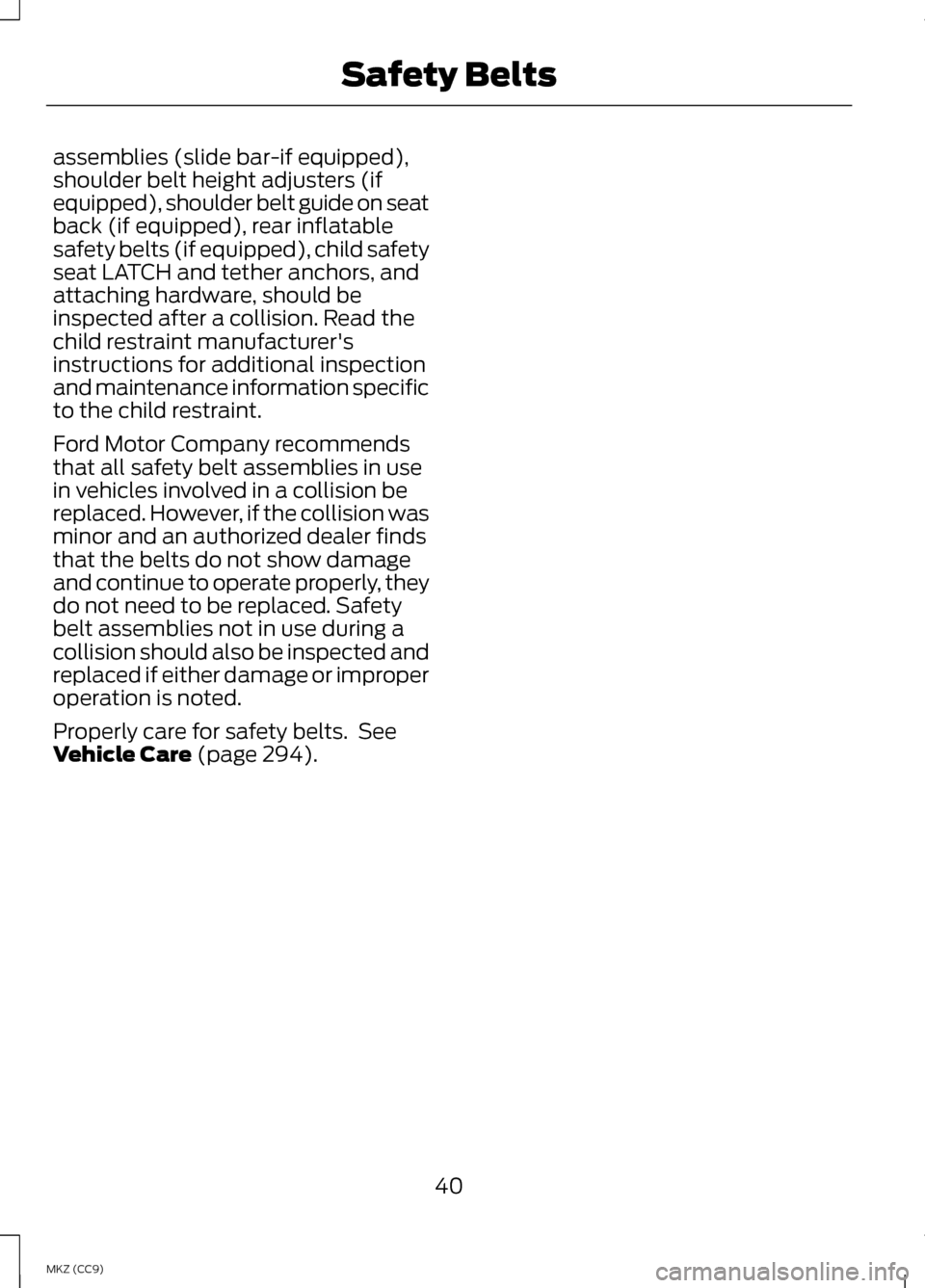
assemblies (slide bar-if equipped),
shoulder belt height adjusters (if
equipped), shoulder belt guide on seat
back (if equipped), rear inflatable
safety belts (if equipped), child safety
seat LATCH and tether anchors, and
attaching hardware, should be
inspected after a collision. Read the
child restraint manufacturer's
instructions for additional inspection
and maintenance information specific
to the child restraint.
Ford Motor Company recommends
that all safety belt assemblies in use
in vehicles involved in a collision be
replaced. However, if the collision was
minor and an authorized dealer finds
that the belts do not show damage
and continue to operate properly, they
do not need to be replaced. Safety
belt assemblies not in use during a
collision should also be inspected and
replaced if either damage or improper
operation is noted.
Properly care for safety belts. See
Vehicle Care (page 294).
40
MKZ (CC9) Safety Belts
Page 45 of 475

While the system is designed to help
reduce serious injuries, contact with a
deploying airbag may also cause
abrasions or swelling. Temporary
hearing loss is also a possibility as a
result of the noise associated with a
deploying airbag. Because airbags
must inflate rapidly and with
considerable force, there is the risk of
death or serious injuries such as
fractures, facial and eye injuries or
internal injuries, particularly to
occupants who are not properly
restrained or are otherwise out of
position at the time of airbag
deployment. Thus, it is extremely
important that occupants be properly
restrained as far away from the airbag
module as possible while maintaining
vehicle control.
Routine maintenance of the airbags
is not required.
DRIVER AND PASSENGER
AIRBAGS
WARNINGS
Never place your arm or any
objects over an airbag module.
Placing your arm over a deploying
airbag can result in serious arm
fractures or other injuries. Objects
placed on or over the airbag inflation
area may cause those objects to be
propelled by the airbag into your face
and torso causing serious injury. WARNINGS
Airbags can kill or injure a child
in a child seat. Never place a
rear-facing child seat in front of an
active airbag. If you must use a
forward-facing child seat in the front
seat, move the seat upon which the
child seat is installed all the way back. The driver and front passenger airbags
will deploy during significant frontal
and near frontal crashes.
The driver and passenger front airbag
system consists of:
•
driver and passenger airbag
modules.
• front passenger sensing system. · crash sensors and
monitoring system with
readiness indicator. See
Crash Sensors and Airbag
Indicator (page 50).
43
MKZ (CC9) Supplementary Restraints SystemE151127
Page 52 of 475

The design and development of the
side curtain airbags included
recommended testing procedures
that were developed by a group of
automotive safety experts known as
the Side Airbag Technical Working
Group. These recommended testing
procedures help reduce the risk of
injuries related to the deployment of
side curtain airbags.
CRASH SENSORS AND
AIRBAG INDICATOR
WARNING
Modifying or adding equipment
to the front end of the vehicle
(including frame, bumper, front end
body structure and tow hooks) may
affect the performance of the airbag
system, increasing the risk of injury.
Do not modify the front end of the
vehicle. Your vehicle has a collection of crash
and occupant sensors which provide
information to the restraints control
module. The restraints control module
deploys (activates) the front safety
belt pretensioners, driver airbag,
passenger airbag, knee airbag(s), seat
mounted side airbags, side curtain
airbags and optional rear inflatable
safety belts. Based on the type of
crash (frontal impact or side impact),
the restraints control module will
deploy the appropriate safety devices. The restraints control module also
monitors the readiness of the above
safety devices plus the crash and
occupant sensors. The readiness of
the safety system is indicated by a
warning indicator light in the
instrument cluster or by a backup tone
if the warning light is not working.
Routine maintenance of the airbag is
not required.
A difficulty with the system is
indicated by one or more of the
following:
The readiness light will not
illuminate immediately after
the ignition is turned on.
• The readiness light will either flash
or stay lit.
• A series of five beeps will be heard.
The tone pattern will repeat
periodically until the problem, the
light or both are repaired.
If any of these things happen, even
intermittently, have the supplemental
restraint system serviced at an
authorized dealer immediately. Unless
serviced, the system may not function
properly in the event of a crash.
The safety belt pretensioners and the
front airbag supplemental restraint
system are designed to activate when
the vehicle sustains frontal
deceleration sufficient to cause the
restraints control module to deploy a
safety device.
50
MKZ (CC9) Supplementary Restraints System
Page 103 of 475
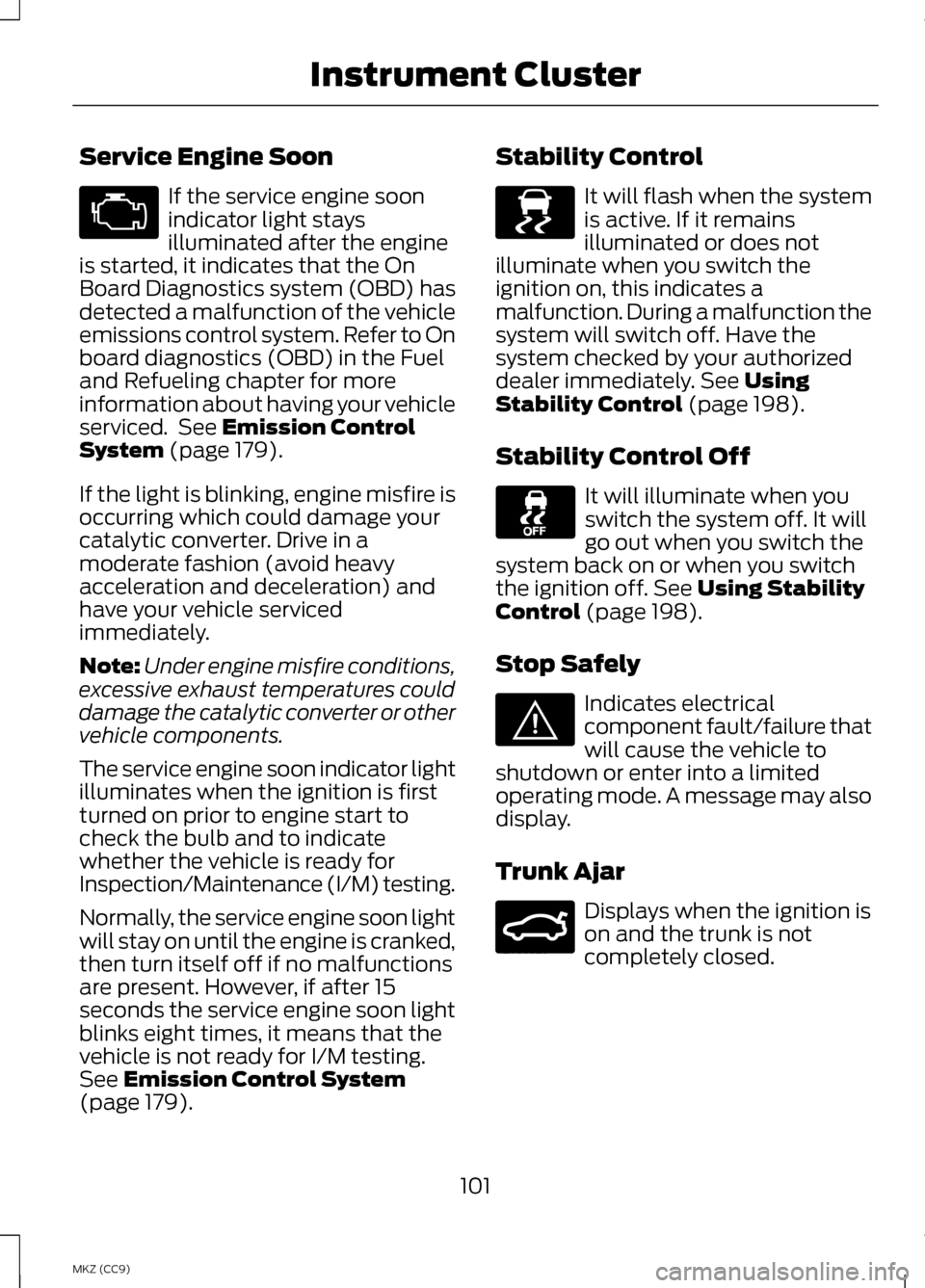
Service Engine Soon
If the service engine soon
indicator light stays
illuminated after the engine
is started, it indicates that the On
Board Diagnostics system (OBD) has
detected a malfunction of the vehicle
emissions control system. Refer to On
board diagnostics (OBD) in the Fuel
and Refueling chapter for more
information about having your vehicle
serviced. See Emission Control
System (page 179).
If the light is blinking, engine misfire is
occurring which could damage your
catalytic converter. Drive in a
moderate fashion (avoid heavy
acceleration and deceleration) and
have your vehicle serviced
immediately.
Note: Under engine misfire conditions,
excessive exhaust temperatures could
damage the catalytic converter or other
vehicle components.
The service engine soon indicator light
illuminates when the ignition is first
turned on prior to engine start to
check the bulb and to indicate
whether the vehicle is ready for
Inspection/Maintenance (I/M) testing.
Normally, the service engine soon light
will stay on until the engine is cranked,
then turn itself off if no malfunctions
are present. However, if after 15
seconds the service engine soon light
blinks eight times, it means that the
vehicle is not ready for I/M testing.
See
Emission Control System
(page 179). Stability Control It will flash when the system
is active. If it remains
illuminated or does not
illuminate when you switch the
ignition on, this indicates a
malfunction. During a malfunction the
system will switch off. Have the
system checked by your authorized
dealer immediately.
See Using
Stability Control (page 198).
Stability Control Off It will illuminate when you
switch the system off. It will
go out when you switch the
system back on or when you switch
the ignition off.
See Using Stability
Control (page 198).
Stop Safely Indicates electrical
component fault/failure that
will cause the vehicle to
shutdown or enter into a limited
operating mode. A message may also
display.
Trunk Ajar Displays when the ignition is
on and the trunk is not
completely closed.
101
MKZ (CC9) Instrument Cluster E138639 E144693 E159323
Page 127 of 475
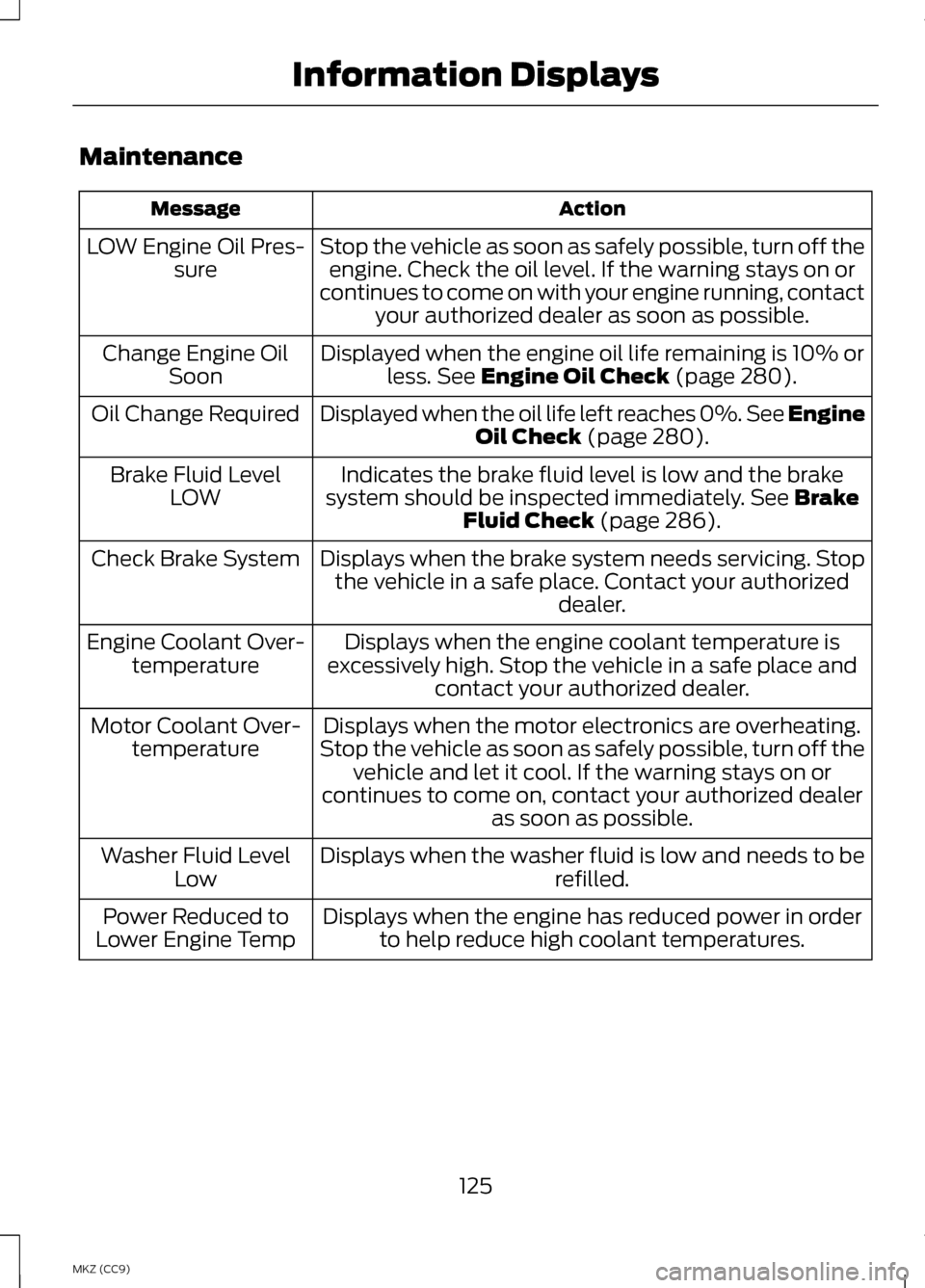
Maintenance
Action
Message
Stop the vehicle as soon as safely possible, turn off theengine. Check the oil level. If the warning stays on or
continues to come on with your engine running, contact your authorized dealer as soon as possible.
LOW Engine Oil Pres-
sure
Displayed when the engine oil life remaining is 10% orless. See Engine Oil Check (page 280).
Change Engine Oil
Soon
Displayed when the oil life left reaches 0%. See Engine Oil Check
(page 280).
Oil Change Required
Indicates the brake fluid level is low and the brake
system should be inspected immediately.
See Brake
Fluid Check (page 286).
Brake Fluid Level
LOW
Displays when the brake system needs servicing. Stopthe vehicle in a safe place. Contact your authorized dealer.
Check Brake System
Displays when the engine coolant temperature is
excessively high. Stop the vehicle in a safe place and contact your authorized dealer.
Engine Coolant Over-
temperature
Displays when the motor electronics are overheating.
Stop the vehicle as soon as safely possible, turn off the vehicle and let it cool. If the warning stays on or
continues to come on, contact your authorized dealer as soon as possible.
Motor Coolant Over-
temperature
Displays when the washer fluid is low and needs to be refilled.
Washer Fluid Level
Low
Displays when the engine has reduced power in orderto help reduce high coolant temperatures.
Power Reduced to
Lower Engine Temp
125
MKZ (CC9) Information Displays